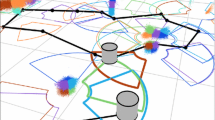Abstract
This paper presents a novel approach to multi-robot site exploration and map building considering the robot team as a self-organising system. The approach has been developed within the framework of the project GUARDIANS. The Map Building process represents not a separate activity, but an inherent by-product of self-organisation. The system consists of an (heterogeneous) robot swarm, a mobile ad-hoc network and an (evolving) topological map of the environment. The proposed map building approach takes advantage of a cooperating robot team (as opposed to a single robot) allowing accurate deployment and localisation in a structured, yet dynamic manner. A topological graph representation of the environment is formed, from which an initial metric representation is elicitable as edges are assigned lengths. This reasonable sketch of the environment can be further developed to a full metric map and be used as the basis of building ad-hoc mobile wireless communication and sensor networks. The presented algorithms also take into consideration sensor limitation and are tested on a group of Khepera III robots, specially upgraded to fulfil the needs of our approach.
Access this chapter
Tax calculation will be finalised at checkout
Purchases are for personal use only
Preview
Unable to display preview. Download preview PDF.
Similar content being viewed by others
References
Alboul, L.: Conceptual Design Document on hierarchical hybrid schema for global map building and localisation. SHU (2009)
Howard, A., Mataric, M.J., Sukhatme, G.S.: Mobile sensor network deployment using potential fields: A distributed, scalable solution to the area coverage problem. In: 6th International Symposium on Distributed Autonomous Robotics Systems (DARS 2002), Fukuoka, Japan, June 25-27 (2002)
Ludwig, L., Gini, M.: Robotic Swarm Dispersion Using Wireless Intensity Signals. In: Distributed Autonoumous Robotic Systems, vol. 7, pp. 135–144. Springer, Japan (2007)
Fox, D., Burgard, W., Kruppa, H., Thrun, S.: A Probabilistic Approach to Collaborative Multi-Robot Localization. Autonomous Robots 8(3), 325–344 (2000)
Fox, D., Ko, J., Konolige, K., Limketkai, B., Schulz, D., Stewart, B.: Distributed Multirobot Exploration and Mapping. Proceedings of the IEEE 94(7), 1325–1339 (2006)
Hokuyo laser range finder, http://www.hokuyo-aut.jp/02sensor/07scanner/urg_04lx_ug01.html
Hokuyo’s URG programming guide, http://www.hokuyo-aut.jp/cgi-bin/urg_programs_en/
Mataric, M.J., Sukhatme, G.S.: Localization for mobile robot teams: A distributed MLE approach. In: Experimental Robotics VIII. ser. Advanced Robotics Series, pp. 146–166 (2002)
Howard, A., Kitchen, L.: Cooperative localisation and mapping. In: International Conference on Field and Service Robotics (FSR 1999), p. 9297 (1999)
Huang, H., Beevers, K.R.: Topological map merging. The International Journal Robotics Research 24(8), 601–613 (2005)
K-Team, Switzerland, Korebot 2 board, http://www.k-team.com/kteam/
K-Team SA, Switzerland, Khepera III homepage, http://www.k-team.com/kteam/
Kurazume, K.R., Hirose, S.: An experimental study of a cooperative positioning system. Autonomous Robots 8(1), 4352 (2000)
Penders, J., Alboul, L., Roast, C., Cervera, E.: Robot swarming in the Guardians project. In: Proc. of ECCS 2007, vol. 6 (2007)
Pugh, J., Raemy, X., Favre, C., Falconi, R., Martinoli, A.: A Fast On-Board Relative Positioning Module for Multi-Robot Systems. IEEE/ASME Transactions on Mechatronics, Focused Section on Mechatronics in Multi Robot Systems (2009)
Rekleitis, I., Dudek, G., Milios, E.: Multi-robot collaboration for robust exploration. Annals of Mathematics and Artificial Intelligence 31, 7–40 (2001)
Tharin, J.: D4.4 Software package: Khepera III drivers for Player/Stage, User’s/Programmer’s Manual for the Software package. K-Team SA, Switzerland
Vlassis, N., Papakonstantinou, G., Tsanakas, P.: Robot Map Building by Kohonen’s Self-Organizing Neural Networks. In: Proc. 1st Mobinet Symposium on Robotics for Health (1997)
Author information
Authors and Affiliations
Editor information
Editors and Affiliations
Rights and permissions
Copyright information
© 2010 Springer-Verlag Berlin Heidelberg
About this paper
Cite this paper
Alboul, L., Abdul-Rahman, H.S., Haynes, P.S., Penders, J., Tharin, J. (2010). An Approach to Multi-robot Site Exploration Based on Principles of Self-organisation. In: Liu, H., Ding, H., Xiong, Z., Zhu, X. (eds) Intelligent Robotics and Applications. ICIRA 2010. Lecture Notes in Computer Science(), vol 6425. Springer, Berlin, Heidelberg. https://doi.org/10.1007/978-3-642-16587-0_65
Download citation
DOI: https://doi.org/10.1007/978-3-642-16587-0_65
Publisher Name: Springer, Berlin, Heidelberg
Print ISBN: 978-3-642-16586-3
Online ISBN: 978-3-642-16587-0
eBook Packages: Computer ScienceComputer Science (R0)




